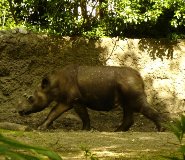 Warning: The Sumatran Rhinoceros (Dicerorhinus sumatrensis) is Critically Endangered, and is at the brink of extinction from human hunting, poaching for their horns, and habitat loss. There are an estimated 300 left in the wild, and a recent rescue effort that ran for 20 years was an abysmal failure. In that program 40 Sumatran Rhinoceroses were captured, tagged, and taken into captivity in hopes of establishing a breeding program. At the end of the 20 year attempt no calves had been born, and nearly all the rhinos were dead – a worse decline than the wild’s current rate. This species is at the very brink of annihilation, but it still is varied enough to be saved with a concerted effort, habitat protection, and poaching prohibition. Of the three subspecies one is already completely extinct – and the other two are very rare.
Warning: The Sumatran Rhinoceros (Dicerorhinus sumatrensis) is Critically Endangered, and is at the brink of extinction from human hunting, poaching for their horns, and habitat loss. There are an estimated 300 left in the wild, and a recent rescue effort that ran for 20 years was an abysmal failure. In that program 40 Sumatran Rhinoceroses were captured, tagged, and taken into captivity in hopes of establishing a breeding program. At the end of the 20 year attempt no calves had been born, and nearly all the rhinos were dead – a worse decline than the wild’s current rate. This species is at the very brink of annihilation, but it still is varied enough to be saved with a concerted effort, habitat protection, and poaching prohibition. Of the three subspecies one is already completely extinct – and the other two are very rare.The Sumatran Rhinoceros is one of the five species left of rhino in the world, it is of those five the smallest and one of the most endangered. Their height at the shoulder is usually around 4-5 feet (1.2-1.5 meters) and they are usually 8 feet in length (2.5 meters). On average they weigh between 1100-1800 lbs (500-800 kg) and have two horns – a large nasal horn with a smaller horn behind it which is usually no more than a stub.
The Sumatran Rhino is a solitary animal for most of its adult life, with the exception of during mating season and calf care. They communicate vocally, and they stamp their feet, or leave feces as a means of letting others know where they are. One of the difficulties in maintaining a rhino population in captivity is the size requirements – each bull requires up to 20 square miles of territory, while the females require 5 square miles. They spend their days in mud wallows to keep cool, and are active at dawn and dusk for feeding. The wallows serve to also maintain their skin, and health – as captive rhinos deprived of this needed daily mud-bath soon die from diseases, or become very sick with inflamed skin, eye infections, hair loss, and broken skin.
Conservation efforts, as stated, have universally failed with one recent exception. In the United States 7 rhinos were sent as a part of the initial 40, and of them 4 had died. However, the three remaining were monitored, and eventually it was discovered that by supplementing a hormone it was possible for the breeding program to succeed. To date three baby rhinos have been born, the first in 2001, and are healthy. It is hoped that with this recent progress in the United States that the population could be saved. The male was later sent to Sumatra in hopes of helping with the females there, however no success has been reported as of yet.
The binomial name of the Sumatran Rhinoceros is Dicerorhinus sumatrensis, and its two remaining subspecies are Dicerorhinus sumatrensis sumatrensis and Dicerorhinus sumatrensis harrissoni. The Sumatran Rhino belongs to the Genus Dicerorhinus, of which it is the only surviving species out of seven other extinct species. Dicerorhinus belongs to the Subfamily Dicerorhininae which contains other extinct species, and that belongs to the Family Rhinocerotidae of which all other rhinos are a member, and there are currently four genera, and out of this only one species is not endangered in some way (but it is close). Rhinocerotidae belongs to the Suborder Ceratomorpha, which contains the Rhinos, and the Tapirs. Ceratomorpha belongs to the Order Perissodactyla, otherwise called the odd-tied ungulates; members include the horse, the donkey, the Onager, the Zebra and many extinct relatives. Ceratomorpha belongs to the Superorder Laurasiatheria which holds the bats, anteaters, whales, moles, and many others, and belongs to the Infraclass Eutheria of which we are members, and are the placental mammals. This in turn belongs to the Subclass Theria of which all placental mammals and marsupial mammals belong – and only the monotremes do not – and Theria belongs to Mammalia.
Fact: The Sumatran Rhino’s closest relative is the extinct Wooly Rhinoceros, which went extinct not more than 8,000 years ago and could be brought back with recent advancements in DNA.
Picture of the Sumatran rhino by nicolaitan, licensed under Attribution ShareAlike 2.0
The Sumatran rhinoceros is listed as Critically Endangered (CR), facing an extremely high risk of extinction in the wild, on the IUCN Red List of Threatened Species
Namings for the Sumatran rhinoceros
A young / baby of a Sumatran rhinoceros is called a 'calf'. The females are called 'cow' and males 'bull'. A Sumatran rhinoceros group is called a 'crash or herd'.Some facts about the
Sumatran rhinoceros
Adult weight : 1260 kg (2772 lbs)
Maximum longevity : 33 years
Female maturity :2738 days
Gestation : 236 days
Weaning : 502 days
Litter size : 1
Weight at birth : 23 kg (50.6 lbs)

Custom Search